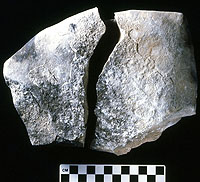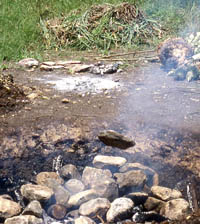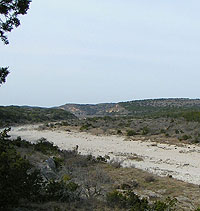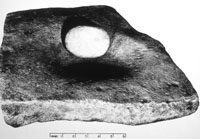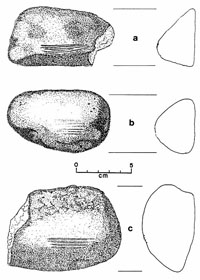Limestone
Among the rocks and minerals found in the Plateaus and Canyonlands, limestone is rivaled only by chert as being the most important natural resource to native peoples. Around 9,000 years ago, the prehistoric peoples of the region began using heated limestone cobbles to cook food. Hot-rock cooking remained one of the defining aspects of the region until early historic times when Europeans arrived and soon disrupted almost every aspect of native tradition. The dominance of the prehistoric pattern is attested to by the tens of thousands of burned rock middens—mounded accumulations of fire-cracked rock (mainly limestone)—discarded cooking stone fragments. In fact, the region as a whole has what may well be the most impressive concentration of hot rock cooking debris known anywhere in North America and perhaps even the world. And it all began with simple limestone rocks.
Limestone makes a good cooking stone because it can be heated to 400-500 C in a simple wood fire and, once good and hot, it holds heat for hours or even days. This property was used to cook food, especially within the layered cooking arrangements known as earth ovens.
Because the Edwards Plateau is a vast expanse of limestone bedrock, suitable limestone rocks could be picked up almost anywhere in the region, with the exception of the Llano Uplift area where metamorphic rocks such as granite predominate. There are also a few areas were the bedrock is mainly calcareous sandstone and both of these rock types were used for cooking as well. But throughout most of the region, limestone was the available and preferred cooking stone. We know this because a number of situations have been documented where limestone was consistently chosen for cooking even though other types of rock were present in the immediate area.
Not all limestone makes good cooking stone. The best is relatively hard (but not too hard, like dolomite), non-porous, and free from cracks. Porous and cracked rocks soak up moisture readily and are actually dangerous to use for cooking because they often shatter explosively when heated. Prehistoric cooks would have quickly learned this and would have chosen dry, intact rocks. Stream-rolled (naturally rounded) cobbles were usually selected, but these weren’t pried out of a wet creek. Most stream valleys have lots of high and dry streamed-rolled cobbles and boulders in places where ancient streams deposited them tens of thousands of years ago. In upland areas, the surface rocks are often angular chunks or tabular slabs, and these forms were used as well.
Limestone cobbles began their short careers as cooking stones about the size of a loaf of bread. Thermal cycles of heating and cooling soon take their toll, creating cracks and breaking apart the intact cobbles into smaller and smaller pieces. Depending on the rock quality and the way it was used, limestone cooking rocks could be reused two to four times before they broke down into fist-sized angular fragments known to archeologists as FCR (fire-cracked rocks).
Limestone rocks were also used for other purposes. Some were used as relatively soft hammerstones for flintknapping (harder rocks like quartzite were usually preferred). Hard limestone rocks were also used for grinding stones (manos/handstones as well as grinding slabs), but harder stones, such as granite and other metamorphic rocks, were preferred. When limestone was the only rock available, that is what they used. Among the more interesting uses of limestone are the curious “incised” stones that are occasionally found at Archaic sites across the Edwards Plateau. Archeologists have speculated that these are shaft straighteners that may have been heated and used to help shape and straighten wooden dart shafts.
![]()
